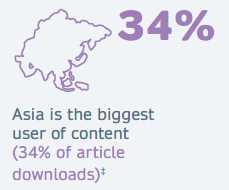1 Million Gold Open Access Articles is only the beginning
In 2021 Springer Nature became the first publisher to achieve the feat of publishing one million gold open access articles. It is a testament to the hard work done by both publishers and the library community, a result of over two decades of improvements and pushing boundaries. As Springer Nature celebrates this significant milestone, it is also a time to look back on the journey, and continued investments in an open research future.
There has always been a lot of excitement about the potential of open access (OA) to change the publishing industry and speed up the process of scientific discovery and progress, but it can be easy to forget that there was also been a lot of skepticism in the early days. Today the benefits of OA are widely acknowledged. OA articles have increased usage and impact, they have the potential to reach those who would not otherwise have had access, with gold OA in particular being shown to have greater access than subscription articles with earlier versions available*. In the early days, however, it was not so obvious to everyone that research should be open, or could be made open in a sustainable manner without compromising on the quality of the work that was published.
* "Going for gold: exploring the reach and impact of gold OA articles in hybrid journals" white paper
Joint approach by library community & publishers
Reaching the milestone of one million gold OA articles is not only proof that much of the early skepticism was unjustified, but it is also a testament to the hard work that has been done by both publishers and the library community. It has not only required the successful promotion of OA to researchers, but also a lot of hard work to ensure that the routes to OA are as accessible and equitable as possible. The changes necessary to reach the one million gold OA milestone didn’t happen overnight, but have been the result of over two decades of improvements and pushing of the boundaries.
Significant OA innovations since 1998

Springer Nature and OA have come a long way since BMC was founded in 1998 as the first commercial OA publisher, with many innovations to ensure that OA is at the heart of all that Springer Nature does:
- OA options have been added to journals: In 2004 Springer was the first publisher to offer OA options on subscription journals, and in 2021 Springer Nature launched OA options for its highly selective titles including Nature.
- Fully OA journals have been launched: In 2005 the Nature Publishing Group launched its first fully OA journals, SpringerOpen launched as a fully OA portfolio of journals in 2010, and in 2011 Scientific Reports was launched, now one of the largest OA journals.
- Subscription journals have been flipped to OA: In 2014 Nature Communications flipped to fully OA to meet the increasing demand from researchers, with new Communications journals open for submissions in 2017.
- Transformative Agreements have been put in place: Springer signed its first Transformative Agreement with the Netherlands, and in 2020 Springer Nature signed the world’s largest national OA agreement with Projekt DEAL in Germany, covering both hybrid and fully OA journals.
- Transformative Journals have been pioneered: Springer Nature pioneered the Transformative Journals in 2019, and in 2020 committed to the majority of its owned journals becoming Transformative Journals from 2021.
Impact that is only possible through OA
Those one million gold open access articles have been downloaded over 2.6 billion times since 2016, in virtually every country in the world, and even in Antarctica. The top hundred articles have been downloaded over 43 million times, and the top article over 1.67 million times (despite only being published in 2020). This is the sort of impact that is only possible through OA making the research as widely available as possible, and gold OA providing access to the version of record.
Speeding up the process of scientific discovery
Continued commitment to invest in open access
Springer Nature is committed and invested to an open research future, and will continue to pioneer OA, OA options and agreements, and champion gold OA as the best and most sustainable route to achieving that. To discover more about Springer Nature’s journey to one million gold OA articles, and to hear what the stakeholders from BMC, the Nature Portfolio, and Springer think about the achievement.



